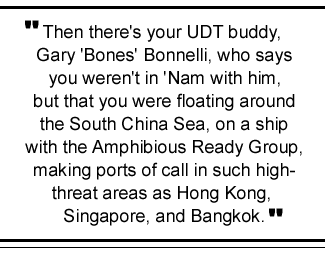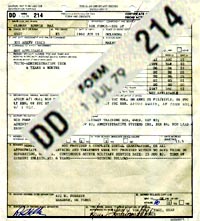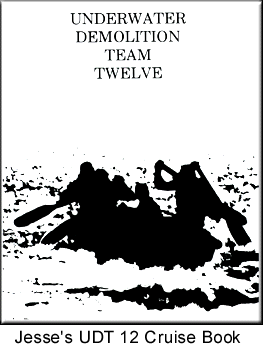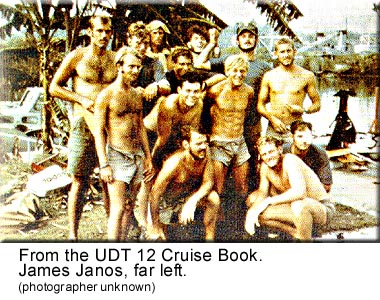 |
|
Jesse's Dangerous Game
A former Navy SEAL commander questions Ventura's claim that he hunted man in Vietnam. by Bill Salisbury POSTED MAY 8, 2001--- MINNEAPOLIS-- A few weeks before the revelation that ex-Navy SEAL Bob Kerrey was involved in the death of civilians during the Vietnam War, Minnesota Governor Jesse Ventura had ignited a controversy of his own by boasting in a confrontational interview with a Minneapolis Star Tribune columnist that he had "hunted man" as a Navy SEAL in Vietnam.
Initial press coverage focused on how Ventura's assertion that "until you hunted man, you haven't hunted yet," had riled many Minnesotans who hunt only non-human game. But more importantly, Ventura's claim invites a revisiting of long-standing questions about his military service, as it raises new ones about what the governor did, or didn't do, in Vietnam. In December, 1999, I wrote an article for the San Diego Reader titled, "Jesse (The Great Pretender) Ventura." The article challenged Ventura's claim that as James Janos he'd been a SEAL in Vietnam. I wrote that Janos had not been a SEAL but merely a member of Underwater Demolition Team (UDT) 12 who had been stationed in the Philippines and not Vietnam. The article relied on several interviews with real SEALS who had been in Nam and UDT men who had served with Janos. I also drew on my 16 years as a SEAL, that included a combat tour as officer-in-charge of SEAL Team 1, Detachment Golf, duty as executive officer of SEAL Team 2 during the war, and a stint as commanding officer of UDT 11 after the war. Before going to press I asked Ventura's spokesman, John Wodele, for the governor's comment. "We will have no comment on something so obviously false," said Wodele in an indignant, imperial tone. (In fairness to Wodele, I didn't tell him of my own SEAL and UDT credentials, but left him to assume I was just some West Coast "jackal" whining and snapping at his boss's heels.) Ventura continued to hide behind Wodele and his stone wall when I appeared on the Fox News Channel program "Hannity and Colmes" a few days after the Reader article appeared. When Fox asked Ventura to respond, Wodele wrote: "The only thing we have ever said is that the UDT and SEAL designation is interchangeable and we don't have any further comment." Why would Ventura - who loves to run his mouth about having been a SEAL - suddenly clam up when I publicly stated in so many words that he was, as my grandma used to say, full of more crap than a Christmas turkey? The governor could have silenced me and his growing pack of critics by simply producing his discharge certificate from active duty, called a DD 214. If he'd been one of America's roughest, toughest, meanest mothers, then that document would list How do I know this? Because as the executive officer of SEAL Team 2, I recommended men for the 5326 designation after they had completed a six month probationary period. Many of these men came from UDTs as 5321/22s. As commanding officer of UDT 11, I awarded the 5321/22 designation to frogmen after their probationary period. Interchangeable designation my ass. If Jesse were a SEAL, his DD 214 would also list at least one "Presidential Unit Citation for service Nam." How do I know this? Because of my duty with both SEAL Teams during the war. Every SEAL who served with Teams 1 and 2 received at least one But no fair relying on public pronouncements by your old toadies in the Teams, or a scrap of paper signed by some fawning Navy bureaucrat 30 years later, saying it's okay for you to call yourself a SEAL because UDTs were decommissioned in 1983. After all, you wouldn't want to be dismissed as a "Paper SEAL" would you? I mean it's okay for some pencil-necked sandcrab like George Plimpton to joke about being a "Paper Tiger" instead of a true major leaguer, but aren't you claiming to be the real deal: an ass-kicking, name-taking Navy SEAL? Of course if you're unwilling to share your DD 214, then your pet jackals in the Twin Cities might want to fire off a Freedom of Information Act request to the Navy. Or they could request a copy of the UDT 12 Command History for the years you were with that team (1971- 1974). They could read the "History" to see if you got any ink for combat exploits. Hell. if you truly saw combat with Team 12 - faced Charley or Clyde at a given time in a given place with the burnt smell of expended rounds in the air - that would be good enough for me. I wouldn't quibble over whether you were a Frog or a SEAL and you could lay this controversy to rest - give it a double tap, an ear shot. Another good resource is the Commander Naval Forces Vietnam monthly combat summaries that cover your time in the Western Pacific.
Or the UDT 12 Cruise Book that chronicled Then there's your UDT buddy, Gary "Bones" Bonnelli, who was one of a very few UDT 12 frogmen stationed in Nam, at a place near the Nam Can Forest called Solid Anchor. Bonnelli says you weren't in Nam with him, but that you were floating around the South China Sea on a ship with the Amphibious Ready Group, making ports of call in such high-threat areas as Hong Kong, Singapore, and Bangkok.
Anyone wanting to avoid the hassle of prying documents from the Navy should get T.L. Bosiljevac's book, UDT/SEAL Operations in Vietnam, (Ivy, 1990.) Bosiljevac, a SEAL officer, reviewed command histories, cruise books, and monthly operational summaries to compile a chronological narrative of every UDT and SEAL combat action in Nam. The Navy-sponsored research was part of his master's thesis at the Naval Postgraduate School. I've also learned from men who served with you in UDT 12 that you deployed to the Western Pacific (WESTPAC) during the war from February to October 1971. I checked UDT/SEAL Operations in Vietnam for that period and here's what I found. UDT 12 is mentioned only twice: "UDT 12 relieved UDT 13 in February as the WESTPAC - deployed underwater demolition team (page 155); "(A four-man SEAL detachment) spent 8 August to 22 September with UDT 12 aboard the USS Grayback to assist in training (page 160)." As you know, the Grayback was a submarine that operated out of Subic Bay. While you were in WESTPAC as a frogman, here's a sampling of what SEALS were up to in Nam:
SEALs interchangeable with UDTs? I think not. But SEALS didn't always win the manhunting contests while you were shooting hoops in the Philippines and pulling liberty in Hong Kong: a SEAL squad transiting the Ham Luong Canal on 28 February took heavy casualties when a B-40 rocket slammed into their boat; Lieutenant Michael Collins of SEAL Team 1 died on 4 March after suffering multiple fragmentation wounds from a VC ambush (more about Mike later); Petty Officer Lester Moe of SEAL Team 1 was killed walking point on 19 March when he stepped on a "Bouncing Betty" mine. And so it went Jesse, for SEALS but not frogmen during your deployment. Of course maybe Bosiljevac somehow missed your manhunting ops. Tell you what - as one old SEAL/UDT manhunter to another - let's share a war story or Many SEALS like to talk about the first man they killed. I sometimes do that. He was a VC courier sliding along the Upper Dong Tam River in a sampan beneath overhanging branches to avoid detection from the air. I brain-shot him with a CAR 15 - a weapon that looks like a toy. I was close enough to see blood and bone spray when the round struck. But I usually don't talk about the first man I killed, Jesse. I usually talk about the first man I watched die. His name was Bobby Neal and he worked for me when I ran three SEAL platoons out of Nha Be 30 miles below Saigon on the border of a 500-square mile swamp called the Rung Sat. Neal took a lot longer to die than the courier. Neal was 18 when he got hit: he'd enlisted at 17 on what you may remember the Navy called a "kiddie cruise." A Chicom grenade that exploded in the well-deck of a Mike boat perforated Neal's stomach lining. After the dustoff helo took him to Binh Hoa, I thought he would make it. I continued to think so until my third visit. On that visit I saw that they'd moved him away from the other wounded in the Quonset hut to a small room behind a partition. He was alone in the room except for a nurse. As I approached Neal's bed the nurse cautioned me that he was very weak. "He's a guarded case," she whispered, "he has peritonitis." At the time I didn't know what peritonitis meant, Jesse, even though I was 26 - which was getting up there for a manhunter in that war or perhaps in any war. I've run the Neal movie through my brain so often that the setting and dialogue remain as clear now as on the day I stood by his bed, looking at his pale, slender body covered from the waist down by a sheet. Neal's eyes were closed, his head turned so that I could see the crescent on his scalp where they had shaved his thick black hair to get at the shrapnel. His arm stretched out to receive the trickle of clear fluid coming through a tube from a bottle above the bed. "Neal," I said softly, "Neal." He opened his eyes and turned his head toward me. His eyes were dark and seemed too large for his face, like the eyes of a child in a Betanzos painting. "Oh, what? Oh, I thought you were someone else." "It's me. How you feeling?" "Not bad, sir. But I can't move. I mean I got so many tubes in me that all I can move is this arm and my head. Used to have a tube up my nose and couldn't even move my head then." With his free hand he grasped the sheet covering him and pulled it farther down. "See all those tubes?," he asked. A T-shaped bandage stretched across the boy's stomach and down his groin; two plastic tubes extended from beneath the bandage to a pair of bottles placed on a low table next to the bed. "Well, those tubes are so I can shit and piss, see. Then there's another tube beneath the bandage to drain pus outa my gut. They change the bandage a lot and Christ does it stink. Like something rotten." The boy began to breathe heavily as if unused to the effort of so much talking. I said, "You look good, Bobby. Just take it easy. Don't talk so much if it's a strain." "Oh no, no. I like to talk." "I brought you some letters. I'll put them on the table and you can read them later, or have the nurse read them to you." "Thank you, sir. Who are they from?" "Two are from your parents." "My parents?" "Yes, from Virginia." "Oh, there must be some mistake, sir. You see my parents are in Saigon. My mother visits me every day." "I see. How are your parents?" "Very fine, sir. Except my mom doesn't like being so far away from me. It's a long drive from Saigon." "Yes, it is." The boy began to speak again but coughed, then gagged on some sputum. He coughed the sputum onto his chin. I untied the olive-drab bandana from around my neck and used it to wipe away the sputum. The nurse heard the gagging and came to the bed. I said, "I have to go, Bobby. I'll be back soon." The boy, exhausted from coughing, nodded and closed his eyes. As I walked away with the nurse I asked, "What's it look like?" "Bad," she replied. "But he's in no pain." Bobby Neal died shortly after I left, Jesse, and then I knew what peritonitis meant. This next story ought to interest you because it's about a SEAL who was a collegiate swimmer. I understand that you were a pretty fair swimmer when you were a young man. Mike Collins swam for the Naval Academy. They named the Coronado Amphibious Base pool for him after he got churched in the Delta near Ben Tre. I wasn't there, but your UDT 12 skipper was on the helo pad at Binh Thuy when they brought Mike in. He'd taken a lot of shrapnel in the face and head. Your old skipper - I'll call him Jake - told me about it one night around a camp fire in Baja where we'd gone to fish a Pacific estuary called estero coyote. We'd had a good day: we were eating fresh-caught flounder and washing it down with a little "Jack in the Bottle." Nobody around but us and the coyotes whining and snapping just beyond our fire as they searched for fish entrails we'd thrown them. "Mike was one of my platoon leaders," Jake said. "He was going up river at night with his platoon on the way to an ambush site when the boat began taking fire from the banks. The boat cleared the kill zone without a scratch. But they decided, hey, lets go back and take those fuckers on. They'd no sooner reentered the kill zone when either a B40 rocket or rifle grenade struck and blasted shrapnel across the boat - killed or wounded every soul on board." "I sent out a SEAL relief force in helos that managed to suppress the VC fire and medevac the dead and wounded. I was on the helo pad when they landed. Collins came off first and even though you could see he was dead - he was just drenched in blood from his head wounds - the docs tried to save him." "They started pounding on his chest trying to get the pump started. They kept at it for at least 10 minutes. Mike's arms and legs were flopping around and I thought maybe he was alive after all. But the movement was just from all the pounding." "Yet they saved a guy named DaCroce. I don't know how. Jesus, he looked awful. So much blood. He had so much blood on him you couldn't see the features of his face. The blood was just caked on - just crusted and caked." In the fireglow I could see Jake was crying, not sobbing, but just quietly crying with the tears tracking down through the fish flakes caught in his four-day whiskers. Then he composed himself and we talked about something else while the coyotes began to yap, growl, and fight among themselves in the darkness. Several years before Jake told me his story, I had attended a ceremony in Coronado, California, when the Navy named the Amphibious Base pool for Mike. I thought about the last time I was with him. We were chasing Southern snap through the bars of Phenix City, Alabama. Mike had just finished jump school at Fort Benning and I was a new Ranger eager to live my life in danger. We got along. We were jocks and we were SEALS. I sat behind his mother at the pool dedication on that sun-filled day in Coronado. I heard her weeping for a son ten years dead. I concentrated on the 50 meter lanes stretching before us, imagining Mike powering into the far wall, exploding out of a flip turn, pulling hard toward us. Then all I saw was empty water. So there it is, Jesse. Now it's your turn to inspire would-be warriors, those who would spare Bambi and be hunters like us, of the most dangerous game. |
||||||||||||||||
| Cursor home |
 the qualification for all the world to see. And if the SEAL/UDT designation were truly interchangeable, the form would reflect that. But I know it doesn't without even looking at it. The UDT designation, or Navy Enlisted Classification (NEC) - was 5321/22 and the SEAL designation was 5326.
the qualification for all the world to see. And if the SEAL/UDT designation were truly interchangeable, the form would reflect that. But I know it doesn't without even looking at it. The UDT designation, or Navy Enlisted Classification (NEC) - was 5321/22 and the SEAL designation was 5326. of the five Presidential Unit Citations awarded those units. UDTs received none. So c'mon, Jesse,
of the five Presidential Unit Citations awarded those units. UDTs received none. So c'mon, Jesse,  your team's deployments. (SEALS didn't have time for such books.) You could even share
your copy with them. One of your former commanding officers at UDT 12 shared his copy with me and said you'd never been in combat. Said he didn't remember you too well at all except as a guy who was good for morale because you had a great sense of humor. Your former CO was with me in Nam before he took over Team 12. He doesn't think the terms UDT and SEAL were interchangeable.
your team's deployments. (SEALS didn't have time for such books.) You could even share
your copy with them. One of your former commanding officers at UDT 12 shared his copy with me and said you'd never been in combat. Said he didn't remember you too well at all except as a guy who was good for morale because you had a great sense of humor. Your former CO was with me in Nam before he took over Team 12. He doesn't think the terms UDT and SEAL were interchangeable. And sure enough, when I read your old CO's Cruise Book I saw Bonnelli and others listed as having been in 'Nam, but all I found about you was that you'd played on the UDT 12 basketball team in the Philippines, at the naval station in Subic Bay.
And sure enough, when I read your old CO's Cruise Book I saw Bonnelli and others listed as having been in 'Nam, but all I found about you was that you'd played on the UDT 12 basketball team in the Philippines, at the naval station in Subic Bay. two and give those who dream of being warriors a glimpse of the glamour. Here are two "no shitters"- as your fellow celeb "Demo" Dick Marcinko might put it - that have stayed with me for a long time.
two and give those who dream of being warriors a glimpse of the glamour. Here are two "no shitters"- as your fellow celeb "Demo" Dick Marcinko might put it - that have stayed with me for a long time.